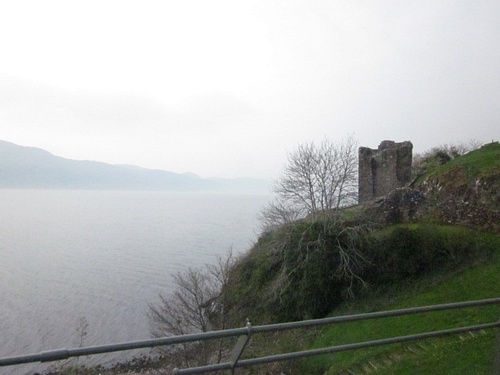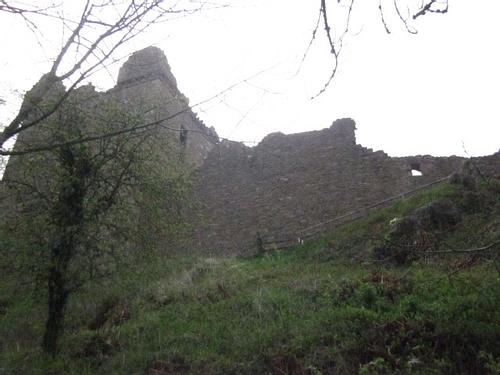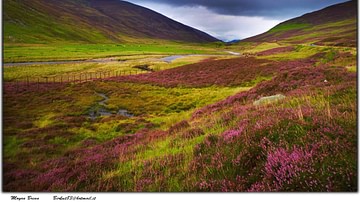Loch Ness is one of the most beautiful lakes in Scotland and no one needs the attraction of the mythical monster to enjoy a visit. The majestic ruins of Urquhart Castle and scenic landscape should be enough of a draw – but there is also the tale of the hero Andrew de Moray to be considered.
The Scottish Highlands are among the most impressive landscapes in the world with some of the most famous sites - Urquhart Castle on Loch Ness, Culloden Battlefield, Clava Cairns - as well as looming mountains, deep glens, and winding rivers. The area is also among the most resonant with the past and every other stream, lake, hill, or valley has its own story to tell of Scottish heroes, heroines, mysterious monsters, and simple everyday life. Castle ruins and old stone farmhouses speak of battles won and lost, generations living and dying, the whole history of the land telling its tale from now-quiet fields and lakes as a visitor goes winding along sharply banked roads rising steadily up to suddenly careen down into hollows and rise again.
On this trip through the Highlands, as on most, Betsy and Emily (my wife and daughter) were my travel mates. We ascended by car from the lowlands, leaving behind the large cities and driving through wide-open fields of grazing sheep below the high crags of sloping mountains under a broad, blue sky. We settled at a B&B in the center of the city of Inverness and then set out to explore one of the best known and most visited sites of the many in the area: Urquhart Castle on Loch Ness.
You say "Loch Ness" and "Monster" follows naturally. This is unfortunate since the lake is bright and beautiful, long and wide, surrounded by the towering slopes of the mountains of the Great Glen. Before we roamed around the castle we went out through the main gate and down to the shore of the lake. I thought what a shame it was that it has this monster reputation and is so often depicted as dark, dreary, and gloomy. The water sparkled brightly in the sun and there were boats, their sails bright white, skimming across the surface. We watched the boats out on the water and the high, green mountains rising up into the blue sky all around.
Other visitors were now coming down to the shore from the castle and, from behind us, I heard a woman say, "Look at those fools out on the water! I would never go out in a boat on Loch Ness with that monster swimming around beneath me." I wanted to respond to her but thought better of it and instead told Betsy and Emily the story of the mythical monster in hopes it might be overheard.
The Monster Myth
The story of the Loch Ness Monster originates in the 7th-century CE work of a monk named Adomnan who died in 704. He is best known for his Life of St. Columba, the hagiography of the famous 6th-century Irish missionary to Scotland. In his work, written almost a hundred years after Columba's death in 597, Adomnan reports that, when Columba visited Inverness in 580/81 to preach to the Picts, he encountered a "water beast" in the River Ness. Columba and his followers happened upon some Picts who were burying a man near the banks of the river who had just been killed by a creature in the water. Columba was touched by the story the men told of how this creature preyed on the local populace and told one of his followers to jump in and start swimming across the river to lure it to the surface.
The water beast appeared and tried to attack Columba's follower, but the saint cried out, "Go no further! Do not touch the man! Go back at once!" and the beast fled. The Picts, as expected, praised Columba's god for their deliverance and welcomed the saint and his entourage to their community instead of pelting them with stones or clubbing them to death as they had done to other Christian missionaries. They then brought him to meet their king, Bridei I, son of Maelchon, who accepted Christianity and allowed the missionaries to build a monastery in his kingdom. Bridei I's conversion is recognized, in fact, as the beginning of the Christianization of Scotland.
The story of Columba and the water beast has been cited repeatedly as ancient proof of the existence of the Loch Ness Monster but there are actually a number of problems with this claim. First and most obvious, the story very clearly states that is it the River Ness, not the lake, where the beast appears. Not that a monster cannot swim downstream if he wants to but, really, why would he? Loch Ness is 745 feet (226 m) deep and 22 miles (36 km) long which is plenty of room for any monster to enjoy itself in without venturing down the much shallower river.
Secondly, except for one alleged sighting in the late 19th century, there were no reports of any kind of monster in or around the lake or River Ness from c. 668 to 1933 when the modern legend of the Loch Ness Monster truly begins. In July of 1933, a Mr. George Spicer and his wife reported seeing "an extraordinary creature" 25 feet (7.6 m) long and four feet (1.2 m) high crossing the road near Loch Ness. The Spicers' report encouraged others in the '30s - and long since - to give their own accounts of sightings and, in time, to create elaborate hoaxes to 'prove' the monster's existence.

Even the famous 1934 photograph of 'Nessie', (known as the "Surgeon's Photograph") which appears in every article or TV program on the monster, has been long discredited as a hoax. Finally, with regard to Adomnan's report of Columba's encounter, the text translates from the Latin as "water beast" (aqua bestia) which could refer to any kind of aquatic animal living in the region c. 6th century CE, and not a monster (monstrum) which would have been regarded and written about differently in the text.
The woman that day by the shore had nothing to fear about boating on Loch Ness and neither does anyone else. The lake is magnificent and, on that warm day with the sun high overhead and the breeze coming in off the water, I could not imagine a more pleasant place to sit and discuss the absurdity of the Loch Ness Monster with my family. After a while, though, we left the shore and walked up the hill toward the walls and tower of the fortress.
The Hero's Story
The name of the castle derives from the Gaelic/Welsh meaning "place by the thicket". Adomnan, the chronicler of Columba, wrote about Urquhart in the same part of his work as the water beast. Columba came to this castle - actually, another castle on this same site - to baptize the Pictish Lord Emchath around the same time he visited Bridei I in Inverness. Betsy and Emily were kind enough to ask about the history of the place as we walked in through the main gate and so I obliged them. It was not just the history of the castle they heard though - it was the history of a Scottish hero few people ever hear about: Andrew de Moray, who took the castle we were walking into from the English in 1297 and a man whom many believe to be the 'True Braveheart'.
Even those who do not know Scottish history know the name of William Wallace. Long before Mel Gibson brought him to world consciousness in the 1995 film Braveheart, Wallace was famous as the hero of the First Scottish War of Independence. Jane Porter's popular 1810 historical novel The Scottish Chiefs (which Braveheart drew upon) popularized Wallace as a romantic figure and he is still seen in that light. His 1297 victory over the English at Stirling Bridge is legendary and one cannot walk through the city of Stirling without being reminded of it. Even so, it could - and has - been argued that Wallace's great standing in Scottish history is based on a fiction and it is actually Andrew de Moray who was the hero of Stirling Bridge.
Andrew de Moray was a Norman Scot of noble lineage, whose family came from Flanders. Nothing is known of his birth, and he enters and exits history between 1296 and 1297. He is first mentioned following the Scottish defeat by the English at The Battle of Dunbar in April 1296. The Scottish forces were massacred after a poor tactical decision by their commander, John Balliol, and Andrew de Moray's father, Sir Andrew de Moray, and uncle, William de Moray, were taken prisoner and sent to the Tower of London where they died in 1298.
Andrew himself was taken to Chester Castle in northern England to be ransomed along with other Scottish nobles. He remained a prisoner there for almost a year until he escaped and made his way back to the family estate in Avoch, northern Scotland, a distance of 405 miles (651km) much of which was hostile territory controlled by the English. Once back in his ancestral lands, he drove out the English forces and raised the flag of insurrection over Castle Ormond. He then set himself to gathering arms, equipping an army, and acquiring intelligence of English positions and strengths. He also found the time to get married and set his estate at Avoch in order.
Throughout 1297, de Moray successfully battled the English in northern Scotland while Wallace was waging his guerrilla war in the south. He besieged Urquhart Castle after ambushing a large contingent of the garrison and, though initially unsuccessful, later took the castle. He burned the English fleet at Aberdeen and took the stronghold at Balconie, and then, in a surprise attack, avoided a frontal engagement with the English to take Duffus Castle and then the strategically important Boharme Castle.
He had now divided the English forces in the north and, with major fortifications under Scottish control, was able to effectively take the remaining castles. Andrew de Moray understood battle formations and tactics and used them to his advantage. Wallace was a master of guerrilla warfare. History is not clear as to when the two men met and joined forces, but it seems it was as late as August of 1297 when Wallace suggested the two make a concerted effort to drive out the English. The joint forces of the two leaders met either at Dundee or Perth and converged on the small city of Stirling.
Wallace was highly regarded as a charismatic and capable guerrilla commander but had no experience in formal battle. That Andrew de Moray would have been in command of the joint forces at Stirling seems clear on three points:
- The strategy employed of dividing the English forces, as well as the deployment of the troops, seems in keeping with tactics repeatedly used by de Moray in his previous military campaigns.
- There is no similar military engagement executed by Wallace prior to Stirling to set precedent for his success on the field that day.
- Andrew de Moray's name and seal always precedes Wallace's on all extant correspondence, indicating that he was commander of the rebel forces and Wallace the second-in-command.
At the Battle of Stirling Bridge, 11 September 1297, it is recorded that de Moray led from the front, after allowing part of the English force to cross the bridge, and split the opposing army in half; precisely the tactic he had employed before against his enemies. The battle was a great victory for the Scots, and the English abandoned Stirling. De Moray, however, was wounded either by arrow or sword and later died of these wounds, sometime in November of 1297. After Stirling Bridge, William Wallace never won another battle. At Falkirk, in 1298, his forces were massacred on the field by the army of Edward I of England (r. 1272-1307) and, at the Battle of Roslyn in 1303, Wallace refused to command and offered only tactical suggestions which were in keeping with a guerrilla fighter, not a field commander. Every successful major siege and field engagement throughout 1297, including the famous Battle of Stirling Bridge, was planned and executed by Andrew de Moray.
The Source of Braveheart
How did Wallace come to so completely eclipse de Moray? It came about through the power of medieval literature. In the year 1477, a minstrel at the court of James IV of Scotland, known as Blind Harry, composed the epic poem The Acts and Deeds of the Illustrious and Valiant Champion Sir William Wallace which credited Wallace with all manner of heroic feats from slaying lions in France to cleverly outwitting the English in multiple engagements.
At the Battle of Stirling Bridge, Harry claims, Wallace devised a clever trap to be sprung on the bridge which plunged the English army into the water below. No such trap has ever been mentioned by any chroniclers of the actual battle. This work of fiction glorifying Wallace and his exploits, however, was so well written and so engaging that it became accepted, if not as actual history, at least as the primary lens through which Wallace came to be viewed.
None of this is to claim that William Wallace deserves no honor for his sacrifice in the cause of Scottish freedom; only to clarify his actual role in the First War of Independence 1296-1328. Andrew de Moray is increasingly coming to notice without detracting from Wallace's legacy. An article in the 26 April 2015 edition of The Scotsman reports how three granite plinths have been erected at the site of The Battle of Stirling telling the story of Wallace, de Moray, and the battle with emphasis on de Moray's role. The article's title, Scotland's Forgotten Hero Andrew de Moray Honoured, expresses well the long-overdue recognition.
Conclusion
We wandered through the empty rooms and climbed the battlements of Urquhart as I told Betsy and Emily about the history of the place. It was April and there were few other visitors there. We had the place almost to ourselves. I described for them de Moray and his men in the 1297 campaign, before Stirling, out in the surrounding fields ambushing the constable Sir William FitzWarin and FitzWarin's frantic escape inside the walls which surrounded us.
De Moray lay siege to these very walls, I told them, but could not take the fortress as he lacked siege engines. His determination prevailed, though, and he finally did take the castle later in 1297. It was held by a Scottish garrison until 1303 when the English captured it. In 1307 it was taken by Robert the Bruce on his grand conquest through the Great Glen, seven years prior to his victory over English forces at The Battle of Bannockburn on 24 June 1314.
After this, the castle changed hands and flags many times, fell into ruin, was rebuilt and renovated by the Grant family starting in 1509 and continuing as late as the 1640's when it was abandoned. Cromwell ignored it when he marched through, the Jacobites attacked it, Orangemen destroyed it, and neighbors raided it for stones to build or repair their homes. It was a complete ruin when the state took over Urquhart in 1913 and began the restoration which saved the castle.

When I finished my lecture, Betsy joked, "This is why we bring you along - so we do not have to hire a guide or stop and read the placards."
We went on together up the stairs and stood on a high, stone landing where we looked out over the ruins of the castle to the lovely Loch Ness beyond. It was no surprise to me that this site is one of the most popular tourist attractions in Scotland. The place breathes history, mystery, and legend but, all that aside, it is one of the most strikingly beautiful landscapes I have ever seen.
Monsters and heroes and momentous battles all seem to fade as one looks out across the lake at the far mountains rising grandly above the waters, their graceful slope and the deep greenery under a high canopy of blue. We visited many fascinating and beautiful locales throughout the trip but, when I think of Scotland, the ruined castle by the shores of Loch Ness always comes first to mind; not scary or gloomy or Hollywood heroic but transcendent and timeless in its majestic beauty and the stories it has to share.








